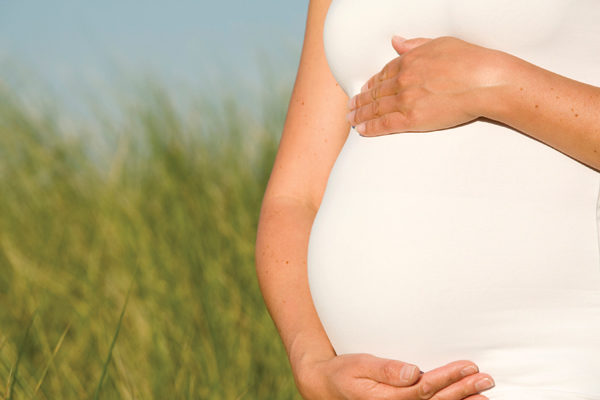During pregnancy, a woman’s body goes through countless changes. Accommodating for the growth and survival of another person can take a toll on a woman’s body, which is why it is important for pregnant women to take pre- and postnatal vitamins. Prenatal vitamins are specially formulated multivitamins that make up for any nutritional deficiencies in the mother's diet. While the supplements contain numerous vitamins and minerals, their folic acid, iron and calcium content are especially important. There are several components of a prenatal dietary regimen that are very important and are highly recommended for pregnant women by physicians (1).
Nutritionally Preparing for Baby
Folic acid is a B vitamin that helps the body make healthy new cells. Folic acid is one of the most important nutritional components of prenatal nutrition because it can reduce the risks of having a baby with a serious birth defect of the brain and spinal cord. A baby with spina bifida, the most common neural tube defect, is born with a spine that is not closed. The exposed nerves are damaged, leaving the child with varying degrees of paralysis, incontinence and sometimes mental retardation (2). The American College of Gynecologists recommends pregnant women (and those trying to conceive) take 600 mcg/day.
Foods with folic acid in them include leafy green vegetables, fruits, dried beans, peas and nuts. Enriched breads, cereals and other grain products also contain folic acid. Many mothers assume that they can get all of the folic acid they need from food, but this is untrue. It is actually harder for your body to absorb folic acid from food than it is to absorb the folic acid found in prenatal vitamins. Research has shown that taking a prenatal vitamin with folic acid can reduce the risk of neural tube defects in babies by up to 70% (3).
Similarly, low levels of choline are associated with an increased risk for spinal cord defects. When the levels of choline are normal, then it has a protective effect for preventing spinal cord defects. And, inositol protects against the development of neural tube defects.
Calcium is another vitamin that is very important to take during pregnancy. Calcium can prevent a new mother from losing her own bone density, as the fetus uses the mineral for bone growth. Increasing calcium supplementation during pregnancy decreases the risk for high blood pressure (preeclampsia) during pregnancy.
 Iron helps both the mother’s and baby’s blood carry oxygen. A low level of iron puts you at increased risk of developing anemia. Approximately 20% of pregnant women suffer from anemia caused by an iron deficiency in pregnancy (4). The reason iron deficiency is so common in pregnancy is that women require about twice as much iron as when they are not pregnant. During pregnancy, blood volume increases by about 50%, which can result in an iron deficiency. This often occurs in the second trimester, as the blood volume increases and the baby begins to demand more iron. The biggest risks of low iron to the baby are low birth weight and preterm labor.
Iron helps both the mother’s and baby’s blood carry oxygen. A low level of iron puts you at increased risk of developing anemia. Approximately 20% of pregnant women suffer from anemia caused by an iron deficiency in pregnancy (4). The reason iron deficiency is so common in pregnancy is that women require about twice as much iron as when they are not pregnant. During pregnancy, blood volume increases by about 50%, which can result in an iron deficiency. This often occurs in the second trimester, as the blood volume increases and the baby begins to demand more iron. The biggest risks of low iron to the baby are low birth weight and preterm labor.
DHA serves as another vital supplement for pregnant women. Pregnant and nursing mothers can give their babies an early developmental advantage by taking a prenatal vitamin that contains the omega-3 fatty acid DHA. Studies show that infants born to mothers with higher blood levels of DHA have advanced attention spans well into their second year of life. During the first six months of life, these same babies had attention spans that were two months ahead developmentally of those babies whose mothers had lower DHA levels. DHA supplementation has been suggested to decrease the incidence of postpartum depression (3).
Co-enzyme Q10 (CoQ10) is a dietary supplement that may prevent the onset of preeclampsia, which occurs in 16% of pregnancies (5). Sometimes, this condition results in premature birth and associated complications for the newborn child. In one recent study, pregnant women taking 200 mg of CoQ10 from 20 weeks of pregnancy until delivery had a reduced risk of developing preeclampsia (6).
Probiotics are said to help reduce the chances of gestational diabetes in pregnant women and also help maintain good digestive health.
Other key vitamins include vitamin D, vitamin B6 and vitamin B12.
Multivitamin combinations can vary depending on the nutritional focus. For example, some manufacturers will create multivitamins that have a higher amount of iron than usual, targeting women who are prone to iron-deficiency anemia. Be sure to tell pregnant women about all your offerings in the prenatal nutrition category so they can decide with their physician which formula would work best for them.
Post-Natal Nutritional Needs
Most prenatal vitamins can be beneficial if taken even after giving birth. A breastfeeding mother, for instance, can benefit from many of the same nutrients she took to keep her baby healthy during pregnancy. This is why she must continue to be careful about the foods and beverages she consumes after birth, too. Whatever is in the mother’s diet is now a part of the infant’s diet because nutrients are transferred through breast milk. Therefore, women must maintain a healthy diet and also keep up with taking their vitamins and supplements.
Your store may also want to investigate offerings in the lactation-support category. Supplements are available to support healthy breast milk supply, such as those that contain fennel seed, blessed thistle, milk thistle, fenugreek, anise seed and other herbs. WF
References
1. www.prenatalvitamins.org, accessed Dec. 3, 2010.
2. “Neural Tube Defects,” www.nlm.nih.gov/ medlineplus/neuraltubedefects.html, accessed Dec. 3, 2010.
3. “Pregnancy and Prenatal Vitamins,” www.webmd.com/baby/guide/prenatal-vitamins, accessed Dec. 3, 2010.
4. “Iron,” www.vitaguide.org/iron.html, accessed Dec. 3, 2010.
5. “Pre/Post-Natal Nutrition,” www.expectantmothersguide.com/library/connecticut/ECTnutrition.htm, accessed Dec. 3, 2010.
6. E. Teran, et al., “Coenzyme Q10 Supplementation During Pregnancy Reduces the Risk of Pre-Eclampsia,” Int. J. Gynaecol. Obstet. 105 (1), 43–45 (2009).
Published in WholeFoods Magazine, January 2011









